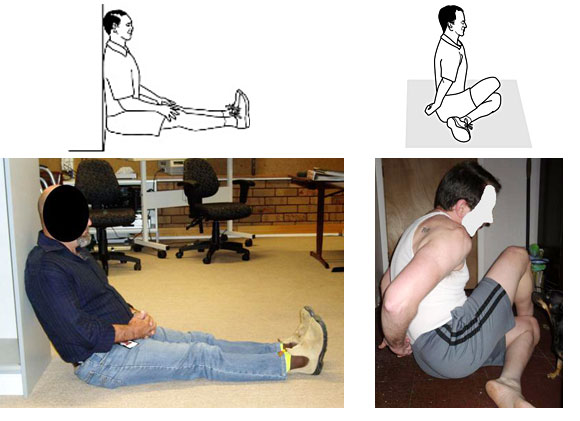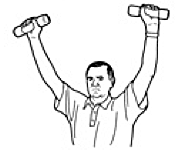The Causes of Musculoskeletal Pain
The Epidemic of Musculoskeletal Dysfunction
Musculoskeletal dysfunction has reached epidemic proportions in communities around the world, with around 50% of people giving themselves 5/10 or less for the status of their musculoskeletal system – where 10/10 is excellent condition and 1/10 is extremely painful.
The number of people with bad backs, stiff necks, frozen shoulders, bung hips, game legs, dicky knees and RSI is legion.
When looking for causes of this epidemic, bad luck is regularly tagged as the culprit.
The real causes,
- a body that is out of alignment
- lack of strength
- lack of flexibility
- obesity
… rarely rate a mention.
For the most part, the medical industry believes back pain ’comes from out of the blue.’
Diagnostic regimes (X-rays and MRIs) are expensive and often of doubtful value, rarely providing information about how the dysfunction happened or what to do about it. Instead, you’ll receive gobbledegook, interspersed with words like ‘annula’, ‘flavum’ and ‘cauda equine’. For all, you know you could be reading an ancient Latin article on horse racing!
All you really want to know is what’s causing your pain and what you need to do to get rid of it.
Not knowing where to look for the cause of the pain is why people end up at the pharmacy. But pain masked is not a problem solved. Musculoskeletal pain is not caused by a lack of medication!
For the most part, a look in the mirror, a photograph or a video clip would provide more information about the cause of the dysfunction than an X-ray.
The most frequently prescribed treatment is an anti-inflammatory tablet, a hot wheat bag, a lie-down, bringing your knees up to your chest, a rub down, a crunch or electric shock therapy under the influence of a physiotherapist or a chiropractor.
As these treatment regimes wear on, often with little effect, they regularly lead to prolonged and expensive treatments and eventually mutilation when a piece of cartilage or disc is given a shave. Treatment no doubt, but not designed to restore the body to neither its designed state of form nor its designed state of function.
Musculoskeletal Dysfunction 101
A body in alignment stays in alignment unless acted upon by a force. That force is the action of tight and weak muscles.
When it comes to musculoskeletal dysfunction, it’s probably best to work on the following assumptions.
- Most musculoskeletal dysfunction is personally generated by people who don’t keep their bodies strong and flexible. Being personally generated there’s a good chance that it can be personally ‘un-generated’.
- Most musculoskeletal dysfunction is eminently fixable.
- Musculoskeletal dysfunction goes with a body that is generally in poor condition. And as Newton may have said, ‘A body in poor condition stays in poor condition unless acted upon by a force.’
- Every dysfunction has a cause. Your job is to find it. Only then will you be able to treat it.
- Musculoskeletal dysfunction rarely comes from ‘out of the blue’. If you don’t find the cause, your search for the cure is likely to be fruitless.
- The cause of the pain is rarely at the site of the pain. Most therapists treat the site of the pain not the site of the cause of the pain.
- Muscles tell bones what to do. Just going for a crunch each week without also embarking on a regular strength and flexibility training program might do your chiropractor a lot of good, but it won’t do you much good!
- There’s a good chance that after reading the Global Back care ebooks you’ll be able to work out the cause of your dysfunction. This is not rocket science.
- The most likely cause is a misuse of one sort or another, usually over a long period of time. If you’ve spent 20 or more years sitting down at a desk all day and don’t have a regular and systematic strength, flexibility and postural alignment program, there’s an 80% chance that sooner or later you’ll succumb to musculoskeletal dysfunction.
- Lao Tzu said a big problem could have been solved easily when it was a small problem.’ This pretty much sums up the history of musculoskeletal dysfunction in one sentence.
- Getting someone to give you an anti-inflammatory tablet and a rub down might give you a warm feeling under your singlet for a couple of hours but it won’t provide the long-term fix which comes with strengthening and loosening the muscles which are designed to keep your body in correct alignment.
- It’s a bit ask expecting to get better without doing something yourself.
The blame game
- Blame tight calf, hamstring and buttock muscles – absolutely.
Lower back and neck pain is a symptom of a pelvis that is out of alignment. When the pelvis moves out of alignment the bones above it move out of alignment. - Blame a weak musculoskeletal ecosystem – definitely.
If you’re not strong enough to do the normal tasks expected of a healthy human being, sooner or later something’s got to give. You’ll tear a muscle, ligament or tendon. Bones will move out of alignment. - A lot more people got better with a gym-based strength program, by attending a yoga, tai chi or pilates class than going to a chemist’s shop.
- Blame sitting down – unequivocally, particularly if you spend most of your sitting down time slouched over with your back in a ‘C’ shaped position, rather than its natural ‘S-shaped position. If you’re not sitting up straight with the back of the chair pressing into your back and your abdomen pressing into your desk you’re setting yourself up for lower back, neck, shoulder and wrist pain.
- blame motion starvation? – you betcha. If you want to avoid muscle, tendon, ligament disc and bone pain, make sure you have a good strength and flexibility training program.
- blame poor alignment? – categorically. If your bones are out of alignment, the bearings start to wear. You get arthritis. Ligaments, tendons and muscles are stretched beyond their pain threshold; discs become herniated.
- blame work? – hardly. A lot of people pull this one on. They are already weak, tight and already out of alignment. They are already in pain. They swivel around to pick up a phone book or lift a box of paper off the floor and ‘do their back in’. The organisation becomes liable because they have neither measured the risk nor managed the risk. When worker’s compensation premiums are not rated against the risk it’s open season for anyone who wants compensation for something they’ve done to themselves. Doctors collude in this swiftie by saying, ‘Because the incident happened at work, work is responsible for getting rid of the pain.’ It’s bunkum.
- blame overuse? – on the contrary. Most musculoskeletal dysfunction is caused by underuse. People don’t have a regular and systematic strength and flexibility training program. Then when they lift something heavier than a knife and fork they become ‘injured’. More bunkum.
- blame lifting – rarely. If you’re strong enough you can lift a 44-gallon drum of petrol into the back of a pick-up. A lot of people would injure themselves by lifting a feather off the floor they’re so weak!
- blame the chair? – doubtful. It’s the way you sit in it. A lot of people con their employer into buying them a $1000 chair. These are people with tight hamstring and buttock muscles, people who can’t do a situp or a press-up and have a 20 kg gut in front of them. Plus they don’t adopt the ideal sitting position. These are people who refuse to sit up straight at their desks. More bunkum.
Sitting down for 20 years without a flexibility training program causes the muscles around the pelvis to tighten up and move the pelvis out of alignment.
- blame the equipment? – unfairly. Bad workmen have always blamed their tools. These days the main tool a lot of people use is their own bodies. Few people are aware of how inadequately they have prepared their own bodies for the work they do or what sort of shape those bodies are in.
Attention is deflected away from the body to the keyboard and the mouse. More bunkum.
- Blame your weight? – yessiree. Being overweight dramatically reduces mobility.
- Blame your stress? – maybe. The effect of stress is to tighten muscles. Tight muscles take bones out of alignment.
The Role of Therapy in the Rehab Process
Manipulative therapy might quicken the time to relieve your pain but it is no substitute for a good exercise program.
In my estimation, massaging and rubbing will count for about 20% of your recovery; the strength and flexibility exercises you do yourself will count for the other 80%
Diagnostic Instruments
If the cause of the pain is rarely at the site of the pain how do you find out where it is?
If you can’t sit up straight there’s a good chance you’ll end up with lower back, neck, shoulder and wrist pain. 
If your hamstring and buttock muscles are too tight, you won’t be able to sit up straight in either of these two positions. And if you can’t sit up straight it’s no wonder you’ve got lower back pain – and neck and shoulder pain.
If your muscles are weak you’re setting yourself up for dysfunction.

If you can’t do 40 press-ups on the trot, men on the toes and women on the front of their thighs, you’re setting yourself up for shoulder dysfunction.

If your shoulder muscles are weak, how long do you think it will be before they become dysfunctional? The rub-down doesn’t improve the strength!
If you purchase copies of the Global Back Care series of ebooks, individually or as a package, I’ll not only provide you with more diagnostic postures that will give you clues as to what’s causing your pain, I’ll provide you with the exercises you need to do to get yourself back into exceptionally good shape, in better alignment, strong enough to do everyday tasks in comfort and pain-free.
Regards and best wishes for a pain-free life.
John Miller
